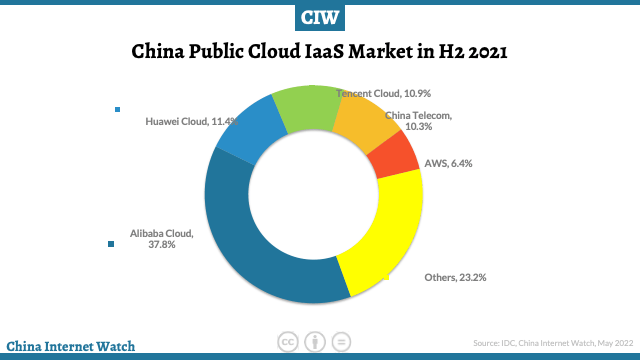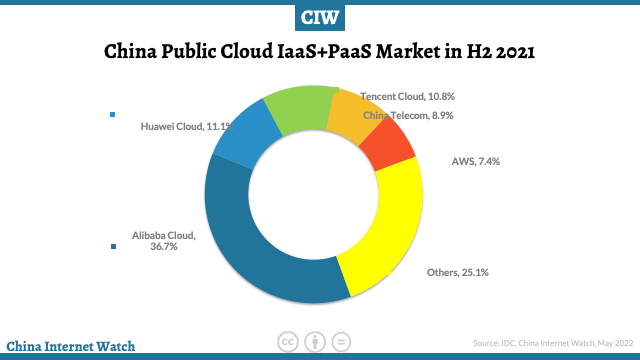In the second half of 2021, the overall market of China’s public cloud services (IaaS/PaaS/SaaS) reached US$15.13 billion, of which the IaaS market increased by 40.1% (47.5% in H1) and the PaaS market increased by 55.7% (53.9% in H1) year-on-year, according to data from IDC.
From the IaaS + PaaS market perspective, the first half of 2021 increased by 43% (vs. 48.6% in H1) year-on-year, down 6% from the first half of 2021, but still maintained the highest growth rate in the world.
In the next five years, China’s public cloud market will continue to grow at a compound growth rate of 30.9%. By 2026, the market is expected to reach US$105.76 billion, and the global share of China’s public cloud service market will increase from 6.7% in 2021 to 9.9%.
The competition in China’s cloud computing extends from focusing on infrastructure to the competition of comprehensive cloud platform capabilities. In addition to increasing investment in infrastructure construction at the IaaS layer, cloud vendors also continue to strengthen chip self-research capability, improve PaaS capability (data processing capability, cloud-native, low code development, etc.), build leading, fast, and perfect solution service capability and implementation and delivery ecology and develop a more comprehensive cloud platform.
The digital transformation of government and enterprises has fully entered the cloud era.
In the first half of 2021, the State Council put forward decisions on deepening the integrated development of new-generation information technology and manufacturing industry and creating new advantages of the digital economy.
Also read: the latest on China’s public cloud market
Local governments and regulators have issued relevant technical specifications and application standards of cloud computing platforms, actively promoted the all-around and in-depth integration of digital technology and social development, and accelerated the application and implementation of digital technology in various industries.
Cloud computing has become the basis and hub of digital transformation. Under this background, there is a huge demand and market space for cloud services in the field of government and enterprises.
Cloud vendors have released their own cloud-native strategies to seize the opportunity from the aspects of products, partners, standard-setting, talent cultivation, and so on.
Industry digitization and low-carbon development have become the mainstream trend. In terms of themselves, cloud vendors continue to improve product energy efficiency and promote the low-carbon development of the cloud industry by investing in innovative energy-saving technologies.
In terms of industry empowerment, cloud manufacturers invest in power electronics technology and integration and innovation with digital technology, promote the development of clean energy and the digitization of traditional energy, bring digital technology to each industry, and support all walks of life to promote low-carbon development through digitization.
In both IaaS and Iaas+PaaS markets, the competition is tight. The leading vendors Alibaba Cloud, Huawei Cloud, and Tencent Cloud have firmly taken the top three positions and jointly have 60% of the market share.


Cloud vendors in the network operator camp grew rapidly, with independent research and development and cloud network integration as their keywords.
The fourth ranked China Telecom Tianyi Cloud formed a full-stack cloud product system by the end of 2020, further deepened to the vertical industry and territory in 2021, sank the resource and service team to the local city, and the local cloud business grew rapidly, creating a new growth level for Tianyi Cloud.
Pricing only the 2nd most important in China for choosing cloud vendors